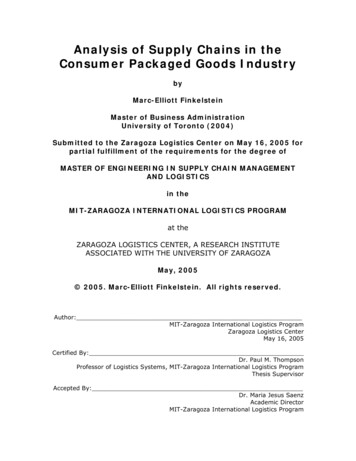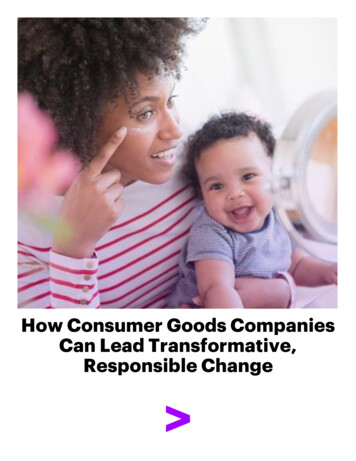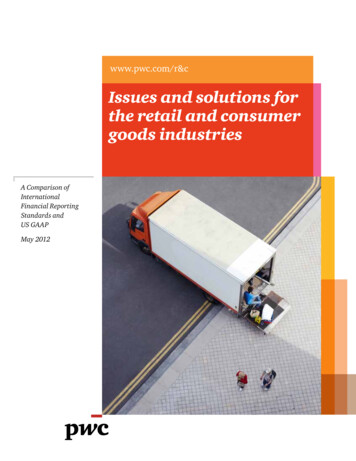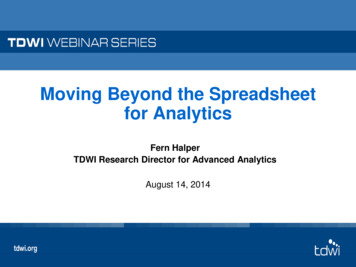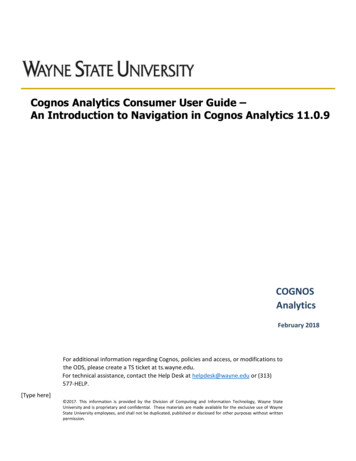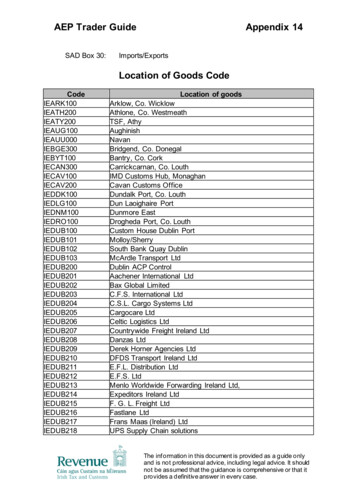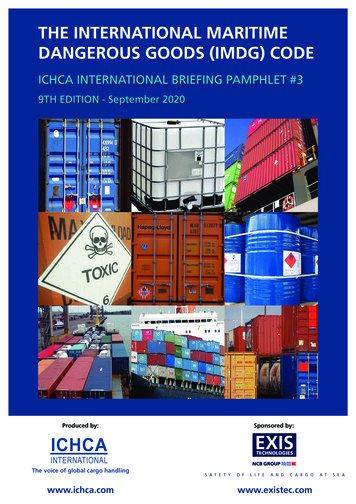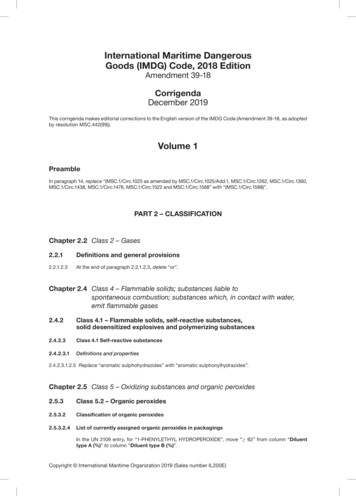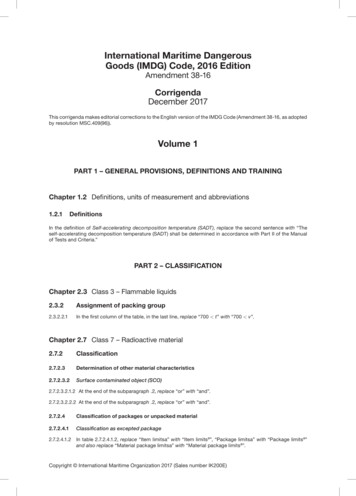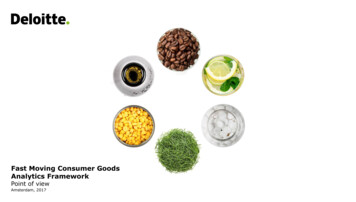
Transcription
Fast Moving Consumer GoodsAnalytics FrameworkPoint of viewAmsterdam, 2017
Key Trends impacting FMCG 2017 Deloitte The NetherlandsSource: Deloitte university press- Consumer product trends Navigating 2020Fast Moving Consumer Goods Analytics Framework2
Using Analytics to stay ahead of the gameEffective use of analytical capabilities will enable FMCG companies to cope with and evenbenefit from the key trends impacting FMCG1Unfulfilled economicrecovery for core consumersegmentsAnalytics supports the shift to value by identifying key price points in the market, defining customersegments, developing new pricing strategies based on competitive intelligence and increasing efficiency inmanufacturing and logistics to reduce costsHealth, wellness andresponsibility as the new basisof brand loyaltyCompanies will experience greater pressure to better align offerings and activities with customer interestsand values. Big Data and analytics help to better understand customer sentiment, preferences and behaviour.At the same time data analytics enables supply chain visibility and identifies potential risksPervasive digitization of thepath to purchaseAn increasingly larger share of consumer's spend and activity will take place through digital channels.Analytics is key in better understanding of purchase and consumption occasions as well as tailoring channelexperienceProliferation of customizationand personalizationIn a world where customized products and personalized, targeted marketing experiences win companiesmarket share, technologies like digital commerce, additive manufacturing and artificial intelligence can give acompany an edge by allowing it to create customized product offerings2345Continued resourceshortages and commodityprice volatility 2017 Deloitte The NetherlandsAnalytics can fuel a better understanding of the resource market volatility and more efficient use of criticalresources in the production processFast Moving Consumer Goods Analytics Framework3
FMCG Analytics Framework 2017 Deloitte The NetherlandsFast Moving Consumer Goods Analytics Framework4
FMCG Analytics FrameworkAnalytic capabilities for better decisions across the FMCG value chainMarketing/SalesBrand x cationAnalyticsSupply ChainDiagnosticsResource igenceBusiness Management & SupportWorkforceAnalytics 2017 Deloitte The Business ProcessAnalysisProgram & PortfolioAnalyticsFast Moving Consumer Goods Analytics Framework5
FMCG Analytics Framework – Marketing/Sales 2017 Deloitte The NetherlandsFast Moving Consumer Goods Analytics Framework6
FMCG Value Chain – Marketing/SalesIn the Marketing/Sales process of the FMCG value chain, analyses are geared towardsimproving commercial performance and customer centricityMarketing/SalesDigital AnalyticsPricing StrategyThe online channels are of increasing importance, also in FMCG. Defining auniform digital KPI framework and building web analytics capabilities is keyto create insights into the digital performance on the ecommerce platforms.The analysis focuses on demand variation at different price levels withdifferent promotion/rebate offers. It is used to determine optimalprices throughout the product/service lifecycle by customer segment.Benefits include increasing sales margin, decreasing markdowns andaiding inventory management.Brand AnalysisTrade Promotion EffectivenessThis analysis focuses on providing insights into the brand perception ofa firm. With the use of (among others) sentiment analysis the firm cancompare the perception of their brand with that of the maincompetitors and create a data driven brand strategy.This analysis focuses on providing insight in both the effectiveness andplanning of trade promotions. These insights allow the company to improvethe aforementioned processes to increase sales while keeping the marketingcosts at the same level.Marketing Mix ROICompetitor IntelligenceAnalyses focus on determining the effectiveness of marketing investments.By reducing ineffective spend and intensifying high return marketing tactics,the marketing mix is optimized leading to higher returns on the overallmarketing spend.Knowledge is power. Knowledge of what your competitors are doing allowsyou to take action quickly in order to gain an advantage. This analysisfocuses on obtaining this knowledge and extracting the actionable insightsthat allow one to form data-driven competitor strategy. 2017 Deloitte The NetherlandsFast Moving Consumer Goods Analytics Framework7
Case study – Digital AnalyticsDefining a KPI framework and embedding it through online dashboardsChallengeFood companyThis global Food company wanted to undergo a digital transformation. However there was little visibility on webanalytics capabilities, no accessibility to in-market web analytics, limited standards and KPI definitions andreporting. For e-commerce there little to no online market share data available in the countriesApproachMarketingDeloitte supported in defining uniform KPIs and a roadmap for implementation for both domains. Deloittesupported in extracting web analytics data and requesting in-market data about on-line market share from thecountries. The first phases for both marketing and e-commerce were to develop tooling to measure and comparedigital performance across target countries for both marketing and e-commerceAnonymizedAnonymizedAnonymizedDigital SalesBenefitsFood company 2017 Deloitte The Netherlands Delivered a marketing dashboard & KPI framework with global definitions Delivered a (hosted) e-commerce dashboard & KPI framework with global definitions, also making webanalytics more financial by measuring the financial impact of web analytics Finally, the roadmaps for both marketing and e-commerce providing clear guidance on maturing in the area ofonline marketing and e-commerceFast Moving Consumer Goods Analytics Framework8
Case study – Brand AnalysisInvestigating brand perceptions by assessing positive and negative opinionsregarding the firmChallengeThe firm wanted to investigate its brand perception by assess positive and negative opinions regarding the firm.They wanted to be able to highlight locations showing positive and negative perceptions. The client also wantedto compare their firm with the main competitors in order to create a data-driven brand strategyApproachThe project involves a web spider which extracts related and unstructured data from the internet from a numberof different sources (social media, blogs, news feeds etcetera). The analysis is then carried out in a text miningtool to process the data for sentiment related content and output the results to an interactive dashboard forvisualizationResultsBrand analysisThe results of the analysis include sentiment scores across the business areas and a root cause analysis. Theseenable a real-time understanding of their online brand and identification of the differentiating factors betweenpositive and negative perceived programs/areas. The delivered insights can be used to determine the necessaryactions in order to promote the firm’s brand in certain programs/areasBrand analysisBrand analysis 2017 Deloitte The NetherlandsFast Moving Consumer Goods Analytics Framework9
Case study – Omni channel voice of the customerAnalysis of customer voice topics and sentiment across multiple channelsChallengeCustomers leave their voices across different channels such as company website, third party resellers, customerservice emails, telephone and social. Capturing, classifying and combining data from these channels ischallenging. Our solution enables CMOs to focus their attention where it is most requiredApproachThis proof-of-concept focusses on three channels (own website, third party website and social). First webscraping used to collect raw customer voices from different channels in different markets. Then a classificationmodel is used to identify key topics and subtopics for each voice, another classification model is used to identifythe product(category) of the topic, and finally sentiment analysis is performed on each of the voices. The resultsare visualised in an interactive dashboardResultsSentiment analysis across channels The solution provides insights into the sentiment of voices per product category, per market Key topics are visible and trending topics can be assessed by product category, channel or market The solution provides a quick overview of all voices across all products, channels and markets, but also enabledrill-down to the voice levelTopic classification and frequenciesTrending topics per product / channel 2017 Deloitte The NetherlandsFast Moving Consumer Goods Analytics Framework10
Case study – Marketing Mix ROIThe use of combined online & offline Marketing Mix Modelling to improve theMarketing ROIChallengeDeloitte was engaged in improving return on marketing spend and optimizing the advertising investment mixwith disparate departments, differing measuring systems and differing priorities to improve marketing ROIacross both offline and online channels simultaneously. This case was executed for an omnichannel retailerApproachFirst the metrics needed for the model were prioritized across products, channels, and categories. A datawarehouse was built to hold the required variables for each product that was needed to continuously run theMarketing Mix Modelling. With all the data present, the Marketing Mix Model was developed to optimizemarketing ROI by using Scenario analysis and Optimization models. Finally the marketing ROI tracking systemwas implemented to continuously track the results of the modelsResultsScenario analysis The most significant result was that the marketing ROI doubled over a two-year periodMarketing ROIMarketing return curves 2017 Deloitte The Netherlands To ensure recurring improvement, an investment mix allocation change was implemented Finally, there was also a strategy shift to target the most profitable customersFast Moving Consumer Goods Analytics Framework11
Case study – Pricing StrategyUsing analytics to reshape pricing strategiesChallengePrice per segment analysisYears of inorganic growth and sales led customer negotiations to tailored pricing across trade customers,resulting in large and difficult to defend price variance across customers. Pricing differences between accountsexposed this CPG client to downward pressure on pricing when trade partners consolidated or buyersmoved retailersExisting pricing and trade terms structure were not compliant with internal accounting standardsProfitability analysisApproachMargin analysisBenefitsPrice Waterfall 2017 Deloitte The NetherlandsDeloitte developed a consistent, commercially justifiable list of pricing and trading terms. The potential impact ofnew pricing and terms on customers was assessed and a high-level roadmap for execution was established. Thebusiness is supported in the preparation for the implementation of the new pricing and trading terms Single common list price for each product Revised ‘pricing waterfall’ and trade terms framework Customer and product level impact analysis Trade communication strategy High-level implementation roadmapFast Moving Consumer Goods Analytics Framework12
Case study – Trade Promotion EffectivenessBuilding a shared reporting and analysis solution that allows fortrade promotion evolutionChallengeA client’s desired end state with regard to BI was a single integrated and shared reporting and analysis solution;delivering value in a single version of the truth throughout the organization. As part of this solution they wantedto gain insight in trade promotion effectiveness through two key dimensions, promotional performance andpromotional planning. This case was executed for a CPG clientApproachTrade promotion analysisInterviews within the company showed that trade promotion management & evaluation is not a focus oncorporate level, but very important on regional level. In order to create a cohesive overview into trade marketingeffectiveness across different dimension (regions, channels, categories, products & sales person) Deloitte had totie several data sources together, such as GFK panel data, Nielsen scanning data, IRI data and the client’s ownfactory dataAccount performanceResultsBudget analysis 2017 Deloitte The Netherlands A tool that allows the client to evaluate trade promotion performance. This way they can evaluate the successof promotions and the drivers behind it A tool that allows the client to evaluate trade promotional planning. As a result they can easily gain insightinto what they are executing according to the year’s promotion plan and whether the trade promotion spendand discounts are in check with planning & budgetFast Moving Consumer Goods Analytics Framework13
Case study – Competitor IntelligenceCreating an overall view of the category market postChallengeOverall viewIt is important to understand how products are offered to the end consumers via the different retail outlets.Therefore, understanding the competitive market of suppliers as well as retailers is keyThe aim of this initiative is to combine disparate data sources in order to develop a solid understanding of themarket position on individual product and category level. This case was executed from a retailer’s point of viewbut can be directly applied to FMCG companiesApproachProduct category dashboardDeveloping a workflow tool to obtain an overall view of the market as well as an interactive dashboard onproduct sales and market positioning, by identifying and combining different data sources such as: Internal market sales & market research Third party (retailers) sales data (e.g. Nielsen) External data sourcesResultsDashboard Deepdive 2017 Deloitte The Netherlands Overall view of the market positioning on individual product/category level Ability to focus on root cause analyses for positive or negative developments in product/market sales usinginteractive dashboarding Uncover relative market positions of product groups vis a vis main competitorsFast Moving Consumer Goods Analytics Framework14
FMCG Analytics Framework – Manufacturing 2017 Deloitte The NetherlandsFast Moving Consumer Goods Analytics Framework15
FMCG Value Chain – ManufacturingIn the Manufacturing process of the FMCG value chain, analyses are focused onoptimizing production processes taking in consideration forecasting, planning, efficiencyand risk exposureManufacturingProduction Forecasting OptimizationAsset AnalyticsAnalyses focus on the evaluation of promotion forecasting based on ameasurement framework of forecasting accuracy/error, bias andstability. Improving forecasting accuracy can potentially lead toreductions in excess inventory, lower labour costs, lower expeditecosts, holding costs, spoilage discounts and reduced stock-outs.Analyses focus on the prediction of the lifetime of long term assets such asbuilding, large machinery and other structural elements. This is done bycalculating the influence of for instance weather, material and usage ofthe assets.Production EfficiencyProduction PlanningAnalyses focus on proactively addressing challenges such as the increase ofefficiency and reduction of costs, but also to help identify opportunities forconsolidating facilities and determine outsourcing and offshore transfersolutions for international and domestic organizations.Analyses focus on the support of delivering more scientific and data basedreal time contingency plans by generating optimal solutions in short timewindows after certain disruptions happen.Workforce SafetyQuality AnalyticsAnalyses focus on the identification of the key factors impacting safetyrelated incidents, the design of measurable interventions to minimizesafety risk and the prediction of types of person(s) who are most atrisk to get hurt.Analyses focus on identifying the high impact issues and understandinga facility’s past performance. The solution consolidates informationallowing a better understanding of the organization’s scope drillingdown to a single facility to make actionable decisions. 2017 Deloitte The NetherlandsFast Moving Consumer Goods Analytics Framework16
el ofAccuracyReceivedby SupplyPlanningChallengeAccuracyAccurate forecasting is a key ability to ensure competitive advantages for every manufacturer. Improvingforecasting capability should be a continuous effort in which periodic or continuous forecasting performanceevaluation is an important element. Forecasting demand in FMCG is challenging due to three main reasons: (1)noise and volatility of demand in market (2) introduction of new products and (3) product promotionsApproachExtra-large error everyx periods may indicateconsistently incorrectassumption(s)Promotion forecasting evaluation is performed based on a three-pronged measurement framework. Performanceis measured in terms of (1) forecasting accuracy (or forecasting error), (2) forecasting bias and (3) forecastingstability. For each of these measurements, several metrics exist and care should be taken to use the mostsuitable performance metricResultsCase study – Production Forecasting OptimizationProduction forecasting is a key capability for many manufacturers, improvingforecasting performance is vital to improve product stock-out, while decreasing costsdue to excess inventoryImproving forecasting accuracy can lead to reduction of excess inventory, lower labor costs, lower expedite cost,holding cost, spoilage discount and reduce stock-outsLAG1 2 3 4 5 6 7 8 9 10 11 12 13 14accuracyProduction forecastperformancestabilityBiasNoise -Bias - 2017 Deloitte The NetherlandsPeriod 1 -Period 2 -Fast Moving Consumer Goods Analytics Framework17
Approach – Production EfficiencyAnalytics is imperative to quickly and comprehensively evaluate your productionprocess, identify opportunities for improvement and customize solutions that quicklydrive measurable resultsResultsValue added activitiesApproachChallengeThroughput statistics 2017 Deloitte The NetherlandsAt any stage of a company’s evolution, improving operating performance is important. Lean methodologiesapplied to nearly any organization enable an efficient and lean enterprise. Analytics can support manufacturersto proactively address the challenges they face today. If applied correctly, analytics can become a major driverfor Lean Six Sigma and other process improvement disciplines seeking to increase efficiency and reduce costsAnalytics assist management teams to devise the appropriate process control strategy and support itsimplementation.Different methods are applied to uncover potential inefficiency and cost reduction opportunities such as: Outlier detection Predictive modelling Scenario modelling Optimization & simulationKey results of production efficiency analytics include; identifying opportunities for consolidating facilities, outsourcing and off shore transfer solutions identifying unprofitable product lines for manufacturing operations reducing idle time for production facilities reducing defects and wasteFast Moving Consumer Goods Analytics Framework18
Case study – Workforce Safety AnalyticsThorough understanding of the dynamics of workplace incidents through the use ofadvanced analyticsChallengeInjury Risk ProfilesTraditional safety analytics defines the scale of the safety problem, but routinely lacks the insights as to whythose safety events occur. A strategic safety profiling analysis can: Objectively identify the key factors and behaviours that impact safety related incidents and then designmeasurable interventions to minimize safety ri
to create insights into the digital performance on the ecommerce platforms. Marketing Mix ROI Analyses focus on determining the effectiveness of marketing investments. By reducing ineffective spend and intensifying high return marketing tactics, the marketing mix is optimized leading to higher returns on the overall marketing spend.

